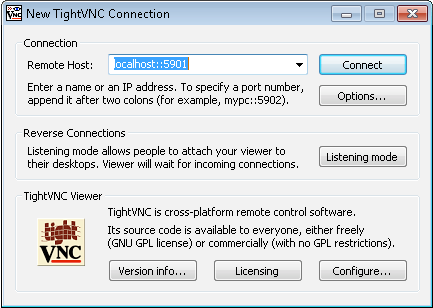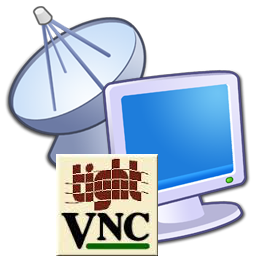

- #Vnc client on mac for tightvnc install#
- #Vnc client on mac for tightvnc drivers#
- #Vnc client on mac for tightvnc driver#
- #Vnc client on mac for tightvnc password#
Open TightVNC Server configuration (right-click the system tray icon or find the Control Interface in the Start Menu).Ensure TightVNC is already running, or is set to run as a service, as above.To capture only select displays, or portions of display(s), it is required to specify the display geometry you wish to capture: Userful by default will fit this feed into a 16:9 canvas. Go to Start > Programs > TightVNC > TightVNC Server (Service Mode) > Register TightVNC Service.įor further configuration options and documentation, see TightVNC's Documentation Pageīy default, TightVNC will capture and broadcast all displays on a system as a single feed.If you unchecked the recommended option "Register TightVNC Server as a system service" during installation, you will need to register TightVNC as a service. Run net stop tvnserver in the Windows command line.Go to Start > Programs > TightVNC > TightVNC Server (Service Mode) > Stop TightVNC Service.Run net start tvnserver in the Windows command line.Go to Start > Programs > TightVNC > TightVNC Server (Service Mode) > Start TightVNC Service.To start the TightVNC Server service one-time:
#Vnc client on mac for tightvnc install#
If you did not install TightVNC as a service during install and wish to change that, the simplest way is to reinstall TightVNC.

#Vnc client on mac for tightvnc password#
Set and record an administrative password (optional).Set and record a password for password-based authentication - this is strongly recommended for security.Register TightVNC Server as a system service when prompted.


TightVNC can be easily installed using standard Windows Installer.
#Vnc client on mac for tightvnc driver#
It is recommended you check with your PC vendor for any available driver and other software updates and install them.
#Vnc client on mac for tightvnc drivers#
Note: This page is provided as a reference only Userful staff may not directly assist in the configuration of applications for your organizations systems.įor best results, you should ensure all drivers on your system are up to date, particularly drivers for your video cards/display adapters. VNC clients and servers from different companies often work together as well, though some companies develop proprietary versions. Since VNC is a protocol, it is cross-platform compatible, meaning Windows VNC clients can connect to and control Linux or OSX VNC servers, and vice versa, etc. TightVNC is a mature, freely-available option that has existed since 2001. There are many different applications available that can function as VNC servers. VNC (Virtual Network Computing) is a standard, not an application. This page provides basic instructions for installing and configuring generic VNC Server applications.


 0 kommentar(er)
0 kommentar(er)
